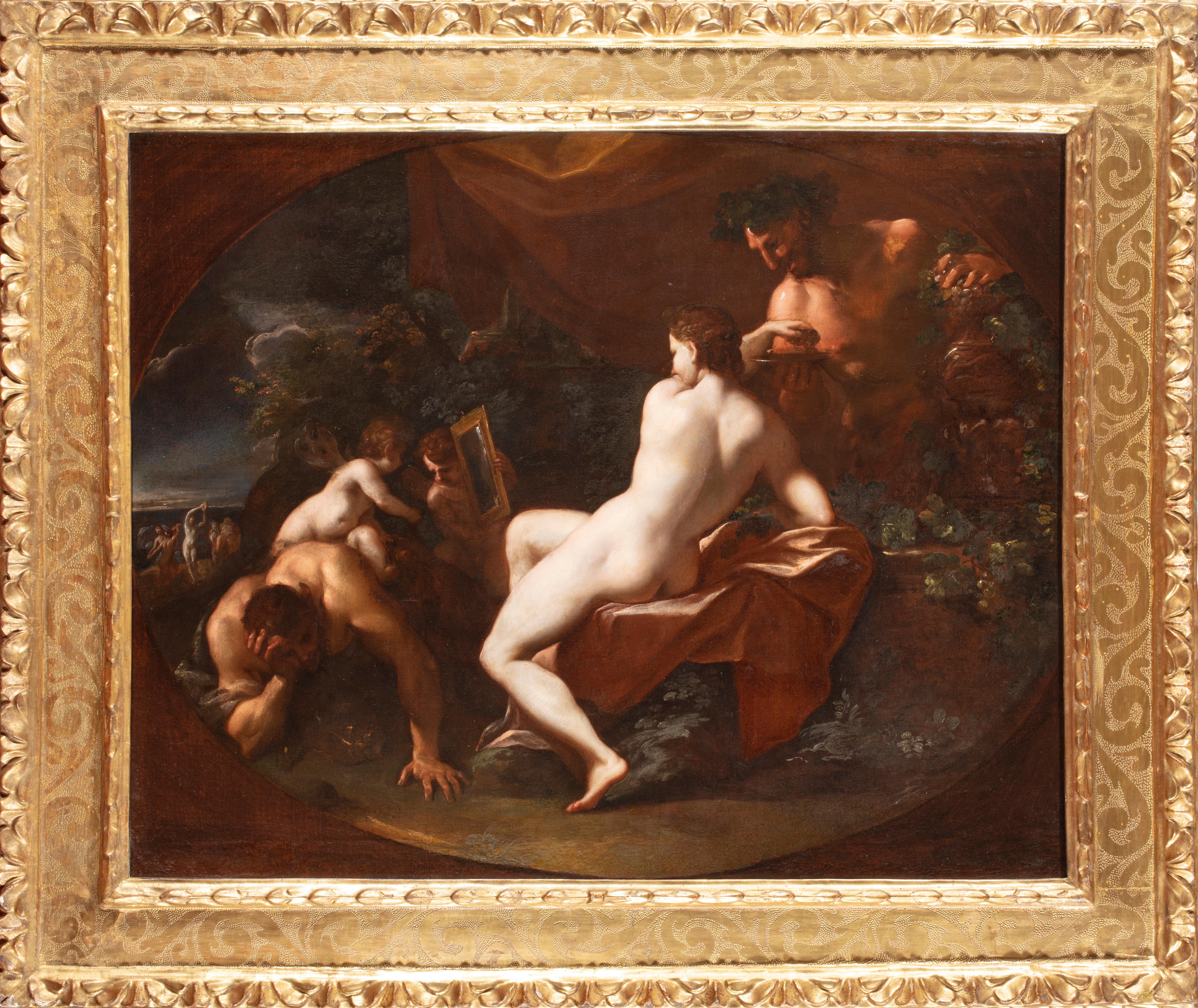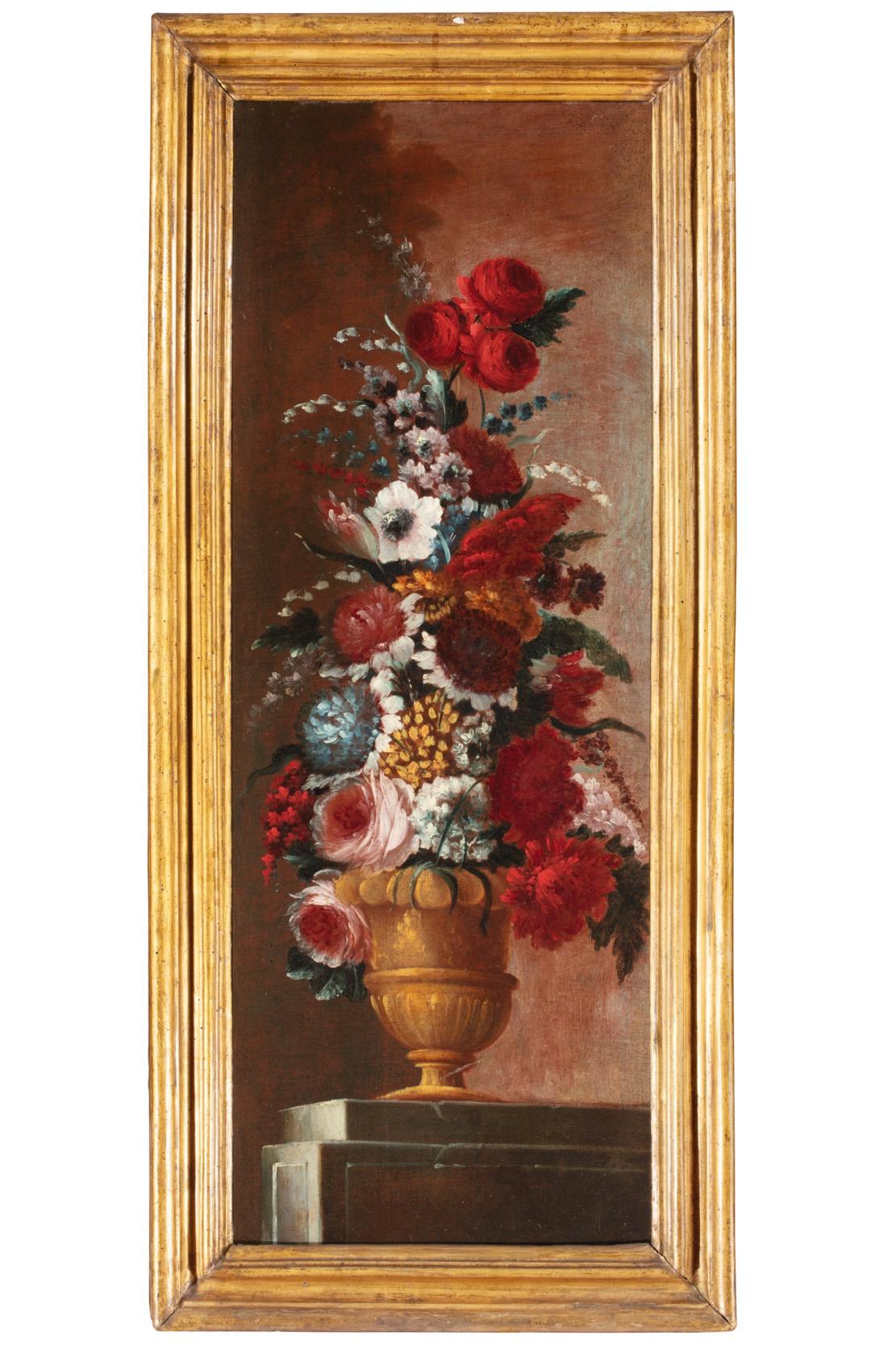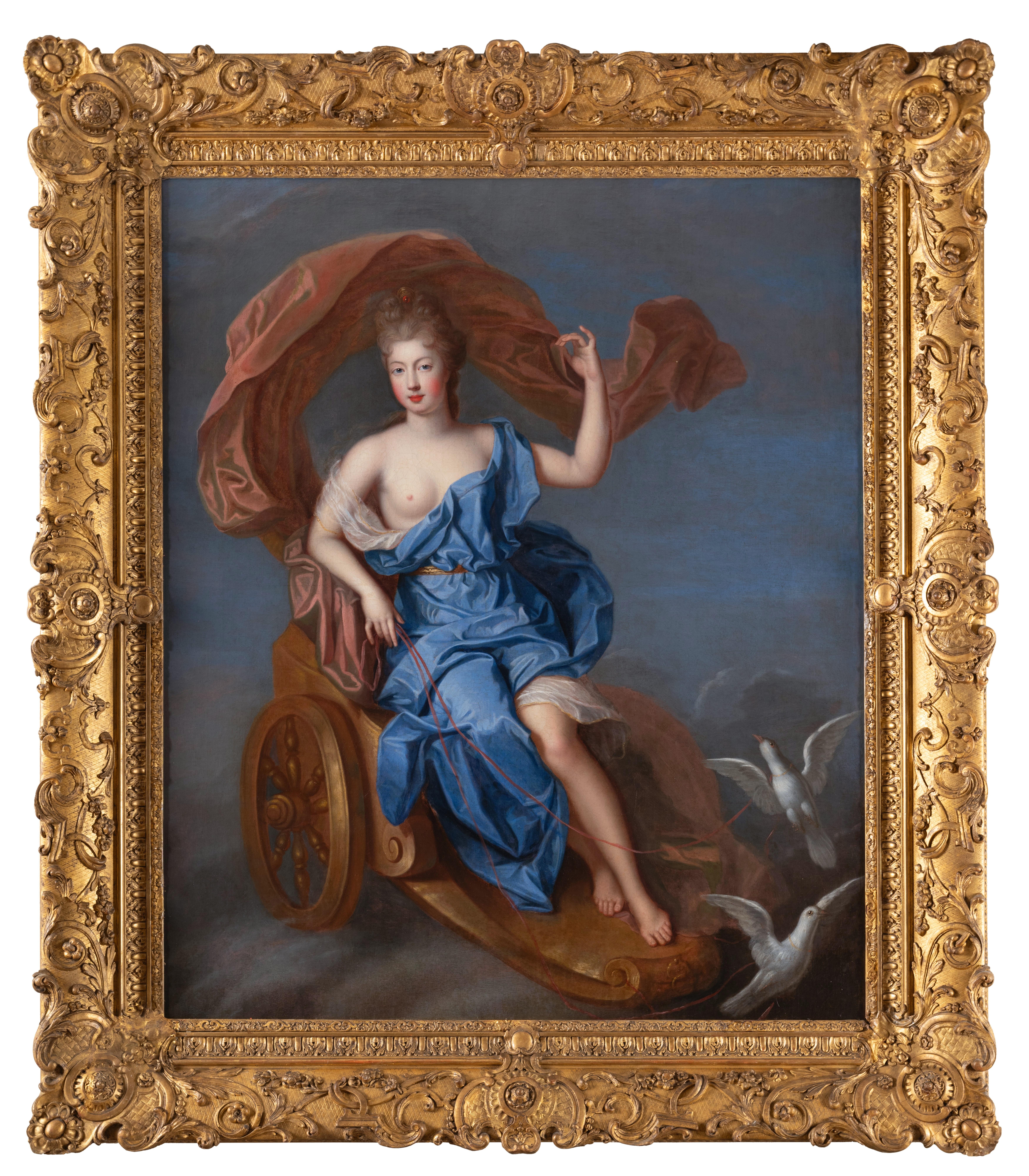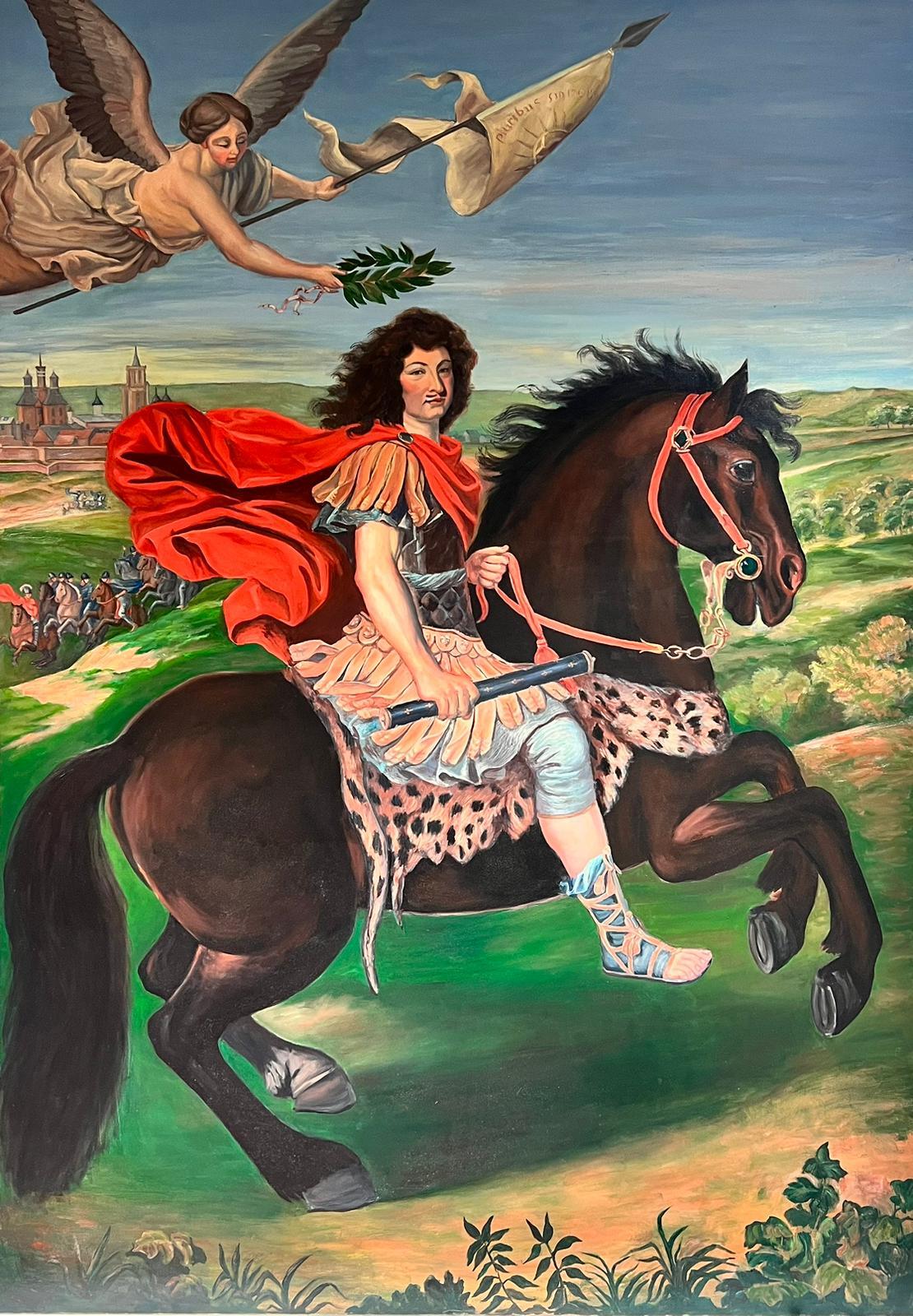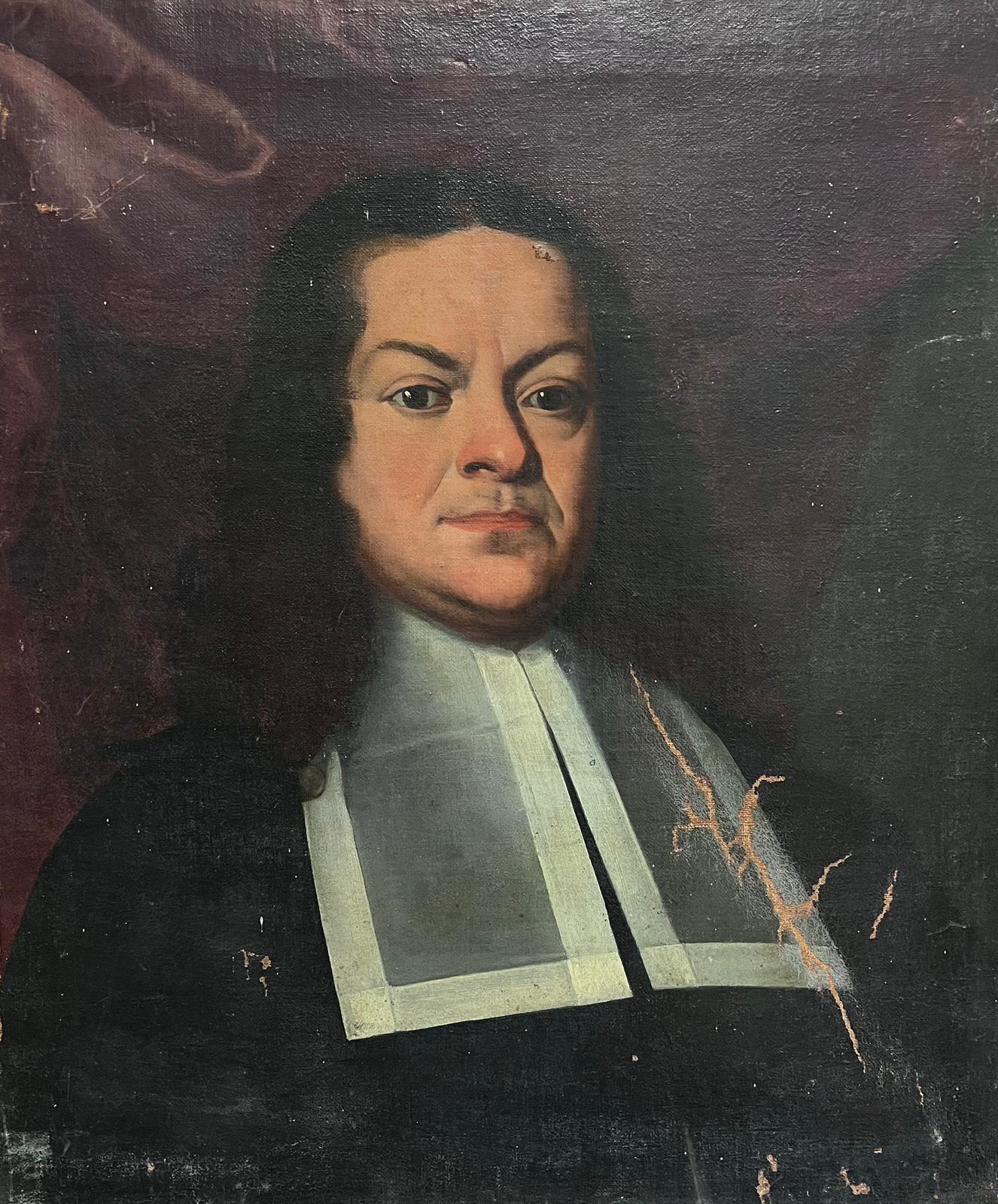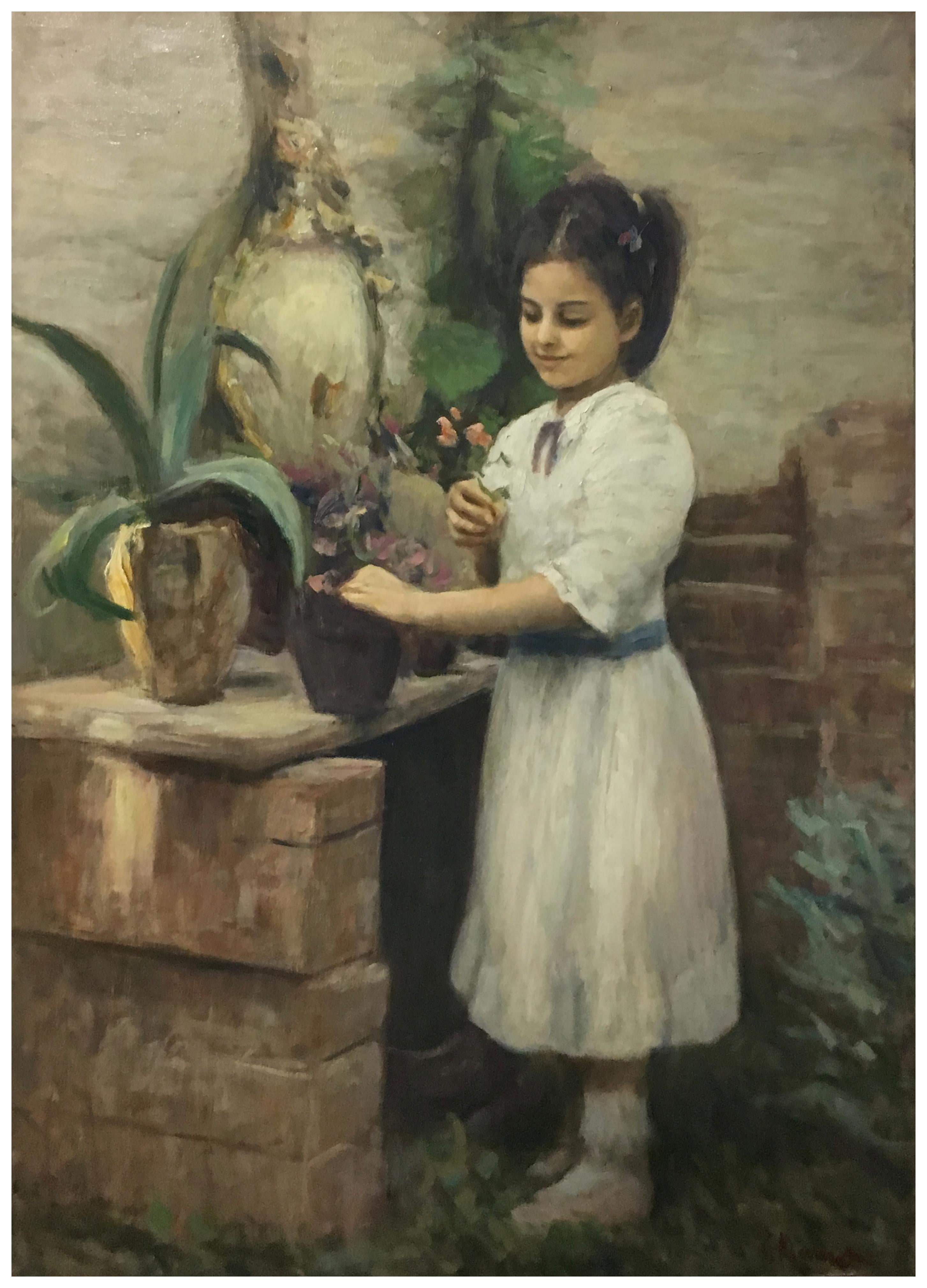Items Similar to Large 17th century Portrait of a noble lady - Castle Caufeild - Godfrey Kneller
Want more images or videos?
Request additional images or videos from the seller
1 of 15
Large 17th century Portrait of a noble lady - Castle Caufeild - Godfrey Kneller
About the Item
17th century Portrait of a lady, possibly from the Caulfeild family, seated in a luxurious landscape holding a basket of flowers
The sitter is looking sweetly at the spectator, whilst holding a delicate red flower in her right hand. In the background, we can see a delicate sculpted relief with classical figures (putti- a possible reference to love or marriage)
Provenance:
Christies February 17th 1956, Lot 11 "Portrait of a lady" as Godfrey Kneller from the property of Major Ynyr. A. Burger, D.L. from Parkanaur, Castle Caulfeild, Co. Tyrone
Oil on canvas 127*102cm , with frame 137*111cm
Late 17th / early 18th century
- Dimensions:Height: 50.01 in (127 cm)Width: 40.16 in (102 cm)
- Medium:
- Movement & Style:
- Circle Of:Sir Godfrey Kneller (1646 - 1723, British)
- Period:Late 17th Century
- Framing:Frame IncludedFraming Options Available
- Condition:As photographed; stable and ready to hang.
- Gallery Location:Antwerp, BE
- Reference Number:1stDibs: LU1423213657232
About the Seller
5.0
Gold Seller
These expertly vetted sellers are highly rated and consistently exceed customer expectations.
Established in 2020
1stDibs seller since 2020
350 sales on 1stDibs
Typical response time: 7 hours
- ShippingRetrieving quote...Ships From: Antwerp, Belgium
- Return PolicyA return for this item may be initiated within 2 days of delivery.
More From This SellerView All
- 17th century Flemish Old Master - A young boy enjoying a pie, allegory of tasteLocated in Antwerp, BE17th century Flemish old master painting, Allegory of taste The very fine painting depicts a young boy, cheekily tasting a delicious pie. He's looking at the viewer with eyes twinkl...Category
17th Century Old Masters Figurative Paintings
MaterialsCanvas, Oil
- Large 17th century Italian old master - Noli me tangere - Christ in the gardenBy Pier Francesco CittadiniLocated in Antwerp, BELarge 17th century Italian old master - Noli me tangere - Christ in the garden with Mary Magdalene The Italian art historian Federico Zeri has conserved a painting in his archives w...Category
17th Century Old Masters Figurative Paintings
MaterialsCanvas, Oil
- 18th century French Old Master Portrait of a Noble ManBy Joseph VivienLocated in Antwerp, BECaptivating French old master portrait of a gentleman around 1710-1720, attributed to Joseph Vivien The painter has wonderfully captured the character and spirit of the gentleman, i...Category
18th Century Old Masters Portrait Paintings
MaterialsCanvas, Oil
- 17th century Dutch old Master Oil - The Smoker - Genre interiorLocated in Antwerp, BE17th century Dutch Old Master oil painting "The delighted Smoker" This painting is a very enigmatic one with an equally thrilling story. We acquired this work some time ago as attri...Category
17th Century Old Masters Figurative Paintings
MaterialsCanvas, Oil
- 17th century Flemish Old master - Silenus feasting - Wine GodLocated in Antwerp, BE17th century old master painting "Silenus feasting", likely studio of Sir Anthony Van Dyck Born in Antwerp in 1599, Anthony Van Dyck entered the studio of Rubens (1577 - 1640) at the age of nineteen. Quickly, the master perceives the talents of the young prodigy and makes him his first assistant. Van Dyck, for his part, has a particular admiration for the man whose name is known throughout Europe. In 1619, he was inspired by a drunken Silenus by Rubens, produced one or two years earlier for a composition on the eponymous theme. This work, now in the Dresden Museum, appears to be the first version of our painting. That work has an illustrious provenance; it was recorded in the private collection of Leopold Wilhelm (Archduke of Austria) in 1662, in 1722 it was bought by the famous German painter Antoine Pesne for the King of Saxony in Dresden (Staatliche Kunstsammlungen Dresden - Gemäldegalerie Alte Meister, Dresden, inventory number 1017). From 1945 until 1955 it was on display at the Pushkin Museum in Moskou, after having been taken by Russia after the Second World War. It was then returned to the Staatliche Kunstsammlungen Dresden where it is still on display. Our painting is of a fine quality and has been painted by a skilled and confident hand. It displays some slight variations in the composition when compared to the original; the legs of Silenus are smoother and less hairy, more humanoid than satyresque. There might also be a pentimento visible at the level of the legs where one observes traces of hair on and under the material. This area can be compared to that of a canvas by Van Dyck kept in Brussels, of a still drunk Silenus whose animal legs are formally treated in the same way as the ones in our composition. Furthermore, the skirt of the figure to the far left has a purplish-red colour in our work, whereas in the first version it appears to be white. There also appear to be differences in the sky, firstly the clouds are shaped slightly different, the sky in our painting has a more vivid colour and there is also a golden hue of a sunset visible to the far left. This treatment of the background appears close to that of a Saint Rosalie, now kept at the Metropolitan Museum in New York and dated 1625, which might offer a reference for dating our painting. In the evanescent aspect, as non finito of its figures, it is interesting to compare our Silenus to a Saint Sebastian, conserved in the Escorial Museum in Madrid. Also, the theme remains rather curious. According to Barnes and Porter, Rubens, like Van Dyck after him, was partly inspired by Book XI of Ovid's Metamorphoses, but a second literary or pictorial source remains unknown (1). For the original composition, Stephan Maaser, art historian, establishes a correspondence between the position of Silenus, referring to that of a Christ at the moment of the Lamentation or the Descent from the Cross (2); the female characters on the left and the male on the right refer more to Mary Magdalene and Saint John than to the Phrygians or the members of a bacchanalian procession. Finally, note that Silenus is not usually a faun. The success of the composition at the time of its public reception and its engraving by Franciscus van der Steen really contributed to the dissemination of the work. At the same time, it testifies to the intense activity of the painter and his studio in Antwerp, before he left to work at the English court. About Silenus: In greek mythology, Silenus was the tutor and foster-father of the wine god Dionysos, who was entrusted to his care by Hermes after his birth from the thigh of Zeus. The young god was raised by Silenus and nursed by the Nysiad nymphs in a cave on Mount Nysa. Silenus was, in essence, the spirit of the treading dance of the wine-press, his name being derived from the words seiô, "to move to and fro," and lênos, "the wine-trough." Once, when Dionysos was travelling through Phrygia, Seilenos became lost and was captured by King Midas. The king treated him hospitably and as a reward Dionysos granted him his golden touch. The artists biography: Born in Antwerp on 22 March 1599, Anthony van Dyck was the seventh child of Frans van Dyck, a wealthy silk merchant, and Maria Cuypers, who was renowned for her embroidery skills. In 1609, when he was ten years old, his parents apprenticed the precocious youth to Hendrik van Balen (1575-1632), a painter of small cabinet pictures and dean of the city's Saint Luke's Guild. Although the length of Van Dyck's stay with Van Balen is not known, it probably lasted three to four years. Van Dyck registered as a master in the Antwerp Saint Luke's Guild on 11 February 1618, by which time he was already in demand as a portrait painter (see the NGA painting, Portrait of a Flemish Lady...Category
17th Century Old Masters Figurative Paintings
MaterialsOil, Canvas
- 17th century Flemish Italian Old Master - The baptism of Christ - ReligiousLocated in Antwerp, BE17th century Flemish old Master painting The present painting is truly a little jewel with its vibrant colours and skilful brushwork. It depicts the Baptism of Christ, a depiction of a tale filled with hope and positivity, it is a very fine example of Malo's talent. We would like to thank Anna Orlando for her assistance in cataloguing this painting. A copy of her entry on this painting will be given to the buyer. She writes about the present painting: The painting illustrated here, unpublished, refers to Vincenzo (Vincent) Malò, a Flemish artist active in Italy and in particular in Genoa in the first half of the seventeenth century, by now well known. The critics who started studying him in the sixties of the last century recognized the initial confusion of our painter with Vincenzo Alemanno (1595-1675); many documents subsequently traced both in the Genoese and Roman archives have partially specified his biographical details, but certainly his identity. Son of a certain Nicola, Vincent trained in Antwerp with David Teniers the Elder and then with Rubens, he was intermittently enrolled in the painters' guild, between 1623 and 1634. It is unlikely that he first arrived in Genoa in 1625 , when the city was at war against the Savoys, and it is entirely probable that his stay in Italy fell between 1634 and the year of his death, documented in Rome in 1644. It were about ten fertile years, also thanks to the lessons from Rubens who had taught him to paint speedily...Category
17th Century Old Masters Figurative Paintings
MaterialsCanvas, Oil
You May Also Like
- 17th Century By Domenico Maria Canuti Toilet of Venus with Cupids and SatyrsLocated in Milano, LombardiaDomenico Maria Canuti (Bologna 1626 - 1684) Toilet of Venus with Cupids and Satyrs Oil on canvas, cm. 79x98 - with frame cm. 102x121 Original gilded wo...Category
Late 17th Century Old Masters Figurative Paintings
MaterialsCanvas, Cotton Canvas, Oil
- 18th Century by Francesco Lavagna Pair of Flower Vases Oil on CanvasLocated in Milano, Lombardia98 x 36 cm each without frame - 112 x 50 cm with frame Antique gilded and shaped wooden box frames Expertise by Prof. Giancarlo Sestieri This marvellous pair of flower vases has b...Category
Early 18th Century Old Masters Figurative Paintings
MaterialsCanvas, Oil
- Late 17th century portrait of a French princess, daughter of Louis XIVBy Pierre GobertLocated in PARIS, FRPortrait of Françoise Marie de Bourbon, Duchess of Orléans as Venus A magnificent painting depicting the princess in all the splendour of her youth, Françoise Marie de Bourbon, known...Category
Late 17th Century Old Masters Figurative Paintings
MaterialsCanvas, Oil
- Enormous French Oil Painting King Louis XIV of France on HorsebackBy Pierre MignardLocated in Cirencester, GloucestershireFrench School, after Pierre Mignard Louis XIV on Horseback oil on canvas, unframed painting: 60 x 41 inches provenance: private collection, UK The paint...Category
20th Century Old Masters Figurative Paintings
MaterialsOil, Canvas
- Large 1700's Italian Oil Painting on Canvas Portrait of a Clerical GentlemanLocated in Cirencester, GloucestershirePortrait of a Clerical Gentleman Italian artist, mid 18th century Circle of Giovanni Battista Carboni (1725-1790) oil on canvas, unframed canvas: 26 x 22 inches provenance: private c...Category
Mid-18th Century Old Masters Portrait Paintings
MaterialsOil, Canvas
- CHILD -Italian School - Figurative - Italy Oil on canvas PaintingLocated in Napoli, ITCHILD - Oil on canvas cm.70x50, Tonino Manna, Italy 2002 Frame available on request from our workshop. in this wonderful painting we admire a girl in a white dress who takes care of ...Category
Early 2000s Old Masters Figurative Paintings
MaterialsOil, Canvas
Recently Viewed
View AllMore Ways To Browse
Delicate Antique
From A Castle
Painting Of A Castle
Antique Frames Lot
A L Holding
Antique Castle Painting
Noble Oil Painting
Large 17th Century Oil Painting
Putti Art
17th Century Flower Painting
Noble Portrait
Portrait Of Noble
Christies Antique
Antique Oil Painting Of Castle
Antique Love Seats
18th Century Painting Of A Lady
Old Master Painting Lady
Putti Paintings
